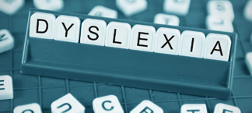3 Ways to Participate in Dyslexia Awareness Month (October)
Categories 
Imagine trying to read a book with the letters and words seemingly jumping and dancing around the pages. Using this Dyslexia Simulator, you can experience what it’s like. Please take a moment to give it a try.
How did you feel? Frustrated? Exhausted? Did it start to make your head hurt? If only individuals with dyslexia could press a “Make it Stop!” button like the one provided with this simulator.
Dyslexia is a common neurological condition that can cause significant challenges in reading, spelling, writing, and even speaking. October is Dyslexia Awareness Month. You can participate by learning the facts, recognizing the signs, and discovering effective interventions and accommodations to support students with dyslexia.
The Facts
- Dyslexia affects 20% of the population.
- From average to highly gifted, dyslexia can occur at all levels of intelligence.
- Dyslexia is not a visual disorder.
- Most children with dyslexia do not reverse letters.
- There is no cure for dyslexia, but quality interventions and accommodations can lead to highly successful students and adults.
Source: https://dyslexia.yale.edu/dyslexia/dyslexia-faq/
This video busts 10 harmful myths and misconceptions about dyslexia.
HTML Video embed
The Signs
As you can see in the table below, the signs of dyslexia look different for different age groups.
|
Examples of Signs of Dyslexia |
|||
|
Preschool |
Grades K-2 |
Grades 3-5 |
Middle School, High School, Adults |
|
|
|
|
Interventions and Accommodations
Because students with dyslexia often experience years of frustration and slow progress, they are particularly vulnerable to stress, anxiety, and other social and emotional challenges. Addressing students’ social and emotional learning (SEL) needs is key to learner readiness. (Check out our blog series that includes strategies and resources focused on the five components of SEL.)
Listen to and acknowledge students’ emotions. Because students with dyslexia struggle with language, it might be difficult for them to identify and express their emotions appropriately. They will often need direct instruction for developing and strengthening their self-awareness and self-management skills.
Help students set realistic and attainable goals to help them see the progress they are making and to experience success - which will boost their self-esteem and confidence. Try using the goal-setting exercise, WOOP:
W – Wish: Students state challenging, yet achievable goals
O – Outcome: Students visualize how they will feel once they accomplish their goals
O – Obstacle(s): Students identify possible barriers that could hinder success
P – Plan: Students devise a specific plan of action to work toward their goals
As you know, appropriate accommodations and instructional methods can make a significant difference for all students, but especially for those with special needs. The International Dyslexia Association provides this free, comprehensive handbook full of classroom accommodations involving materials, interactive instruction, and student performance.
For example:
- Clarify or simplify written directions
- Present a small amount of work at a time
- Supplement learning with instructional games, peer teaching activities, self-correcting materials, and computer software programs
- Use explicit teaching procedures (present an advanced organizer, demonstrate the skills, provide guided practice, offer corrective feedback, set up independent practice, monitor practice, and review)
- Provide students with a copy of the lesson notes or a graphic organizer
- Use a balance of oral presentations with visual and participatory activities. There should also be a balance of large group, small group, and individual activities.
- Use mnemonic instruction to help students remember key information or steps
- Have students turn lined paper vertically for math to keep numbers in the appropriate columns when computing problems
- Provide students with movement/stretch breaks and additional time to complete written tasks
- Allow students to complete projects instead of oral reports; allow students to complete tests orally
- Emphasize on daily review to help students make connections between prior knowledge and new content
How might a school focused on the success of students with dyslexia look? The teachers at Morningside Elementary - a public school in Atlanta, Georgia - utilize an innovative literacy curriculum that includes a well-stocked toolbox of multiple strategies and approaches focused on supporting students with dyslexia. Morningside’s literacy approach also involves a commitment to training teachers and a consistent approach to monitoring student progress.
As noted in the linked article, Case Study – How Morningside Elementary School Helps Dyslexic Students Succeed, “Part of the strength of Morningside’s approach is that it benefits all students, not just those who are dyslexic.”
Learning the facts, recognizing the signs, and discovering effective interventions and accommodations to support students with dyslexia are just a few of the many ways to participate in Dyslexia Awareness Month. What will you do to raise awareness? Please share your ideas.
Here are a few classes related to this topic:
 ADHD: Teaching and Learning Strategies
ADHD: Teaching and Learning Strategies
 Diversity, Equity, Inclusion, and Belonging (DEIB) in Education
Diversity, Equity, Inclusion, and Belonging (DEIB) in Education
 Anxiety Awareness: Strategies to Improve Student Well-being and Performance
Anxiety Awareness: Strategies to Improve Student Well-being and Performance